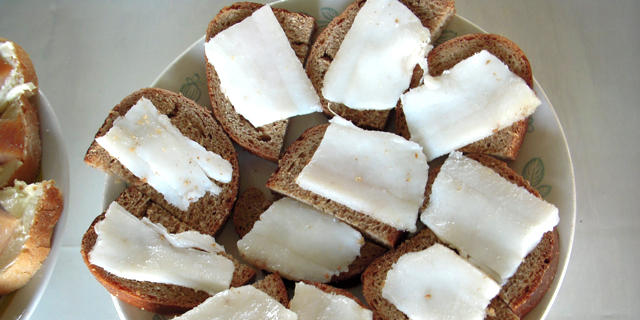Gourmand Dietary Culture
- TOP
- ESSAYS
- Gourmand Dietary Culture
- Ukrainian Salo
Ukrainian Salo
vesta No. 73
Canapé of brown bread with salo
This summer, I went on a boat trip down the Dnieper river. I boarded the boat in Ukraine's capital Kiev, then travelled for 10-days down the river to Odessa on the Black Sea, calling at many ports along the way. It flows easily through the centre of the great plains of Ukraine, known as the granary of Europe. The river is large, with a width, at times, of 20-30 kilometres. The further bank, hidden by the horizon-line beyond, creates the picture of a sea more than of a river. In the places where sandy beaches form between woodlands on the bank, there are campsites and holiday homes. The short summer is lively with people in swimsuits enjoying themselves.
All of the food served on the trip was Ukrainian. I enjoyed local Ukrainian specialties, like the famous Ukrainian borscht, Kiev-style butter-filled chicken, and varenyky dumplings filled with vegetables, meat, or cheese, and covered in butter or sour cream.
Among these specialties, was the lesser-known food, Ukrainian salo. Usually it consists in salted pork fatback, eaten raw. Whichever city you go to, you see piled-up thick white slabs being sold, and this is salo.
Asking a salesperson, it seems they make salo from cutting fat from the back of a pig, with the skin left on. In the summer, it can be smothered in salt and left for a week before eating, but in other seasons, it gets cured in salty water for a lot longer. Sometimes it gets cured with garlic, dill, or other spices.
Usually bacon is made from layered red meat and fat from the ribs, that is salted and then either dried or smoked. Salo is made from the fatty part only. It is a completely white and soft product, because its colour hasn't been changed by smoking it. To convert it into Japanese Yen, it costs around 1,000 Yen per kilo.
Salo is usually eaten in small rectangular slices, cut at around 2 to 3 millimetres thick. It can be eaten in place of butter, spread on bread, or with a salad of raw vegetables. It can also be eaten like a sashimi of backfat.
Unlike the smoky smell of bacon, it doesn't have a particular flavour. Aside from the salty taste, it is flavourless and scentless, and doesn't have the usual heaviness of fat. Its soft and sticky fatty texture is interesting to experience. It's the kind of food that could be addictive once you get used to it. Salo goes very well with Horilka, a type of Ukrainian vodka sometimes soaked with chilli peppers. Strong alcohol dring goes smoothly down the throat, when drunk with a slice of salo on brown bread, and while chewing a clove of raw garlic.
Salo is not only eaten raw. It is also cooked with fatless parts of meat other than pork, or used as the fat with which to fry or stew things. One of the characteristics of Ukrainian cooking is always to brown meat or vegetables in fat before frying, boiling, or stewing them. Ukrainians love the left-over bits of fried salo that remain after cooking.
When traveling through Ukraine in summer, you often see sunflowers. There are sometimes sunflower fields stretching as far as the horizon. The Ukraine, and Moldova, to its West, are some of the world's most renowned sunflower-growing regions.
In the towns, you can buy dried sunflower seeds. You just put them in your mouth whole, chew off and spit out their shells, and eat the soft inners. Most sunflower seeds are in fact used to make oil. Sunflower oil is often used in Ukrainian cooking for salad dressing or frying and deep-frying.
Sunflowers have been cultivated in Ukraine since the 19th Century. In the hundred years or so since then, other vegetable oils and vegetable-based oils have largely been driven out of the market by sunflower oil. Aside from sunflower oil, peasant cooking tends to use salo, as alternatives like olive oil are too expensive.
It is only in recent years, that wealthy countries have decided meat-fat is the enemy in being bad for one's health. Westerners visiting Ukraine, too, often avoid eating raw salo as it is high in fat.
But for countries like Japan and India, where meat has largely been avoided, many people associate meat with feasting, and appreciate the deliciousness of meat-fat, even if it is a high-calorie part of meat.
When I have travelled to Africa and to Pacific countries and asked which parts of meat were considered most delicious, the answer has always been, without fail: meat-fat or liver. In China, the fattiest part of the pig is called fei-rou and the red meat is called shou-rou. Historically, fei-rou has been treated as superior, and sold at a higher price that shou-rou. But with the rise of the economy, meat becoming more available to more people, and an increase in health consciousness, shou-rou is now more expensive than fei-rou.The taste of salo, as a national food-stuff, is an established taste. As long as Ukrainians drink vodka, it is hard to imagine the image of salo at the dinner table will disappear.
Translated with support by Agency for Cultural Affairs, Government of Japan

